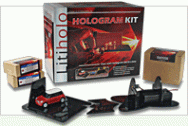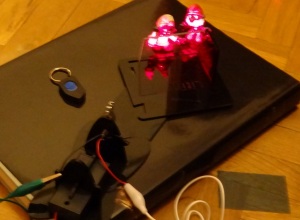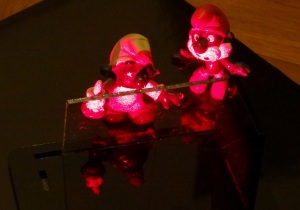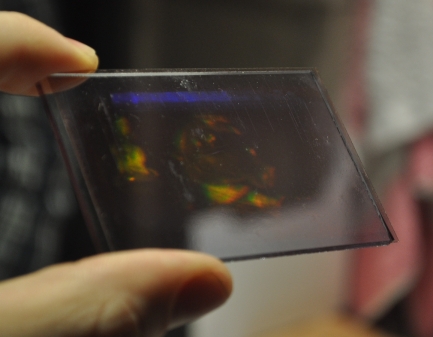Sometime ago I wrote, “Well, isn’t Santa great? Knowing my passion for holography, last Christmas he decided it was about time I stopped feeling miserable about my poor progress in the matter and granted me a Litiholo Hologram kit“. This year he has been even nicer and has provided me with the new Full Color Holography Kit:
Given my great experience with the original kit, I backed this project in Kickstarter. As a seasoned kickstarter backer, I’ve seen projects some delay forever and fail to deliver and others success and provide a great product (for example, openbeam). You never know what to expect when you back a project. Paul from Litiholo has proceeded admirably, with a reasonable delay, and has delivered a product really worth considering, though not lacking some minor flaws. I know some backers are still waiting for their kits and they think shipping is going too slow… if this helps them, delivery time is in the average for successful projects in kickstarter, and more importantly, the kit is worth the wait!, and they really want to get a fully tested and funcional kit.
I have uploaded tons of photos of my first tests in my flickr page, with comments and details of the kit contents, set-up and the like… If you want more information than what is provided here, refer to those photos and their comments.
This is what you get with the kit: a red diode laser, a blue diode laser, a green dpss laser, some plastic pieces that snap together to create a single-beam set-up for reflection holograms (and hopefully transmission), the holographic plates where the holograms will be recorded, and an additional special plate: a ‘holographic optic element’ (HOE) to be used to combine the three laser beams into a single one.
First I tried the default set-up for a single-beam reflection hologram, using some colorful bottle caps that are included in the kit, just following the instructions provided. The set-up is quick and easy to do, but a little tricky to fine tune when trying to align the three lasers. In the end this is what I got (and a video), my first full-color reflection hologram!!!!!:
This hologram is pretty sharp, considering that I did not use any type of vibration isolation, just made it on a regular sturdy desk table.
I’ve made more attempts, some successful, some less, which are discussed in my flickr albums. Compared to other’s reporting extremely bright ones, I seem to have a problem with my green laser, but it works no matter what; this is a simple transmission I did to test the green laser and is one of the sharpest (maybe not brightest) holograms I have ever made:

On a more technical note, I miss some more information about the lasers specs and the film properties. I can understand commercial reasons not to disclose much info, but… (yes, this paragraph is verbatim from the previous post, but the objection still stands!)
The clever way to mix the colors into a single unidirectional beam deserves some notice. The use of the ‘combiner’ HOE is really interesting, and a nice way to solve a problem without the need for mirrors or expensive beam combiners. As I said, getting it directions right is a little tricky, but the solution works fine. This approach, however, limits the possible geometries for recording holograms to those directly devised originally for the kit, but I am sure some creativity can help here…
What I loved:
- I got a nice reflection hologram at the very first try.
- No processing involved makes using this film quick and easy
- It definitely works!
- Color! Hey, you get three lasers!
- Great for schools, demonstrations or plain fun: you need know nothing about holography to make it work.
- I think it makes a great tool for amateurs like me also, to quickly test more complex set-ups, because it removes two variables from the equation: exposure time and processing.
- The kit only allows a limited set of configurations.
- The beam profiles for the three lasers cannot cover the full plate.
- The kit material is fragile, be careful not to drop specially the laser holders… maybe thicker material should have been used.
In conclusion, if you know the original kit, this one keeps the same approach, only in colors… if you liked it, you should love this. If you didn’t, well… you could give it a chance to get some color! If you do not know the original kit, this one makes a great choice, since it actually allows you to do the same it did, and then some.
I really like the kit, and if you are curious about holograms (real holograms, no false hype here) I wholeheartedly recommend it, even though some tweaking in the lasers profiles and plastic material used could improve it. After all this is a beginners kit, and that should be kept in mind, and you get panchromatic plates and three lasers!, you can use this material to try more adventurous set-ups once you master what the kit has to offer.
Now, if only they got a distributor overseas, so we need not pay terrible shipping plus customs for new film…
Keep in mind that when you read this the kit might not yet be widely available… just keep checking litiholo’s site.
Poetry in Motion… or, Mom, look what I did!
“Poets say science takes away from the beauty of the stars – mere globs of gas atoms. I too can see the stars on a desert night, and feel them. But do I see less or more? The vastness of the heavens stretches my imagination – stuck on this carousel my little eye can catch one – million – year – old light. A vast pattern – of which I am a part… What is the pattern, or the meaning, or the why? It does not do harm to the mystery to know a little about it. For far more marvelous is the truth than any artists of the past imagined it. Why do the poets of the present not speak of it? What men are poets who can speak of Jupiter if he were a man, but if he is an immense spinning sphere of methane and ammonia must be silent?”
― Richard P. Feynman
- Car Hologram using Litiholo Holography kit (1)
- Car Hologram using Litiholo Holography kit (2, slower camera motion)
- Smurf figurine reflection hologram on litiholo film.
As Feynman says, this is another kind of poetry: the simplicity of the principles behind these, the details to make it work, and the esthetics, all come together. For details on the holograms, refer to this post.
Litiholo or What’s in a KISS?
Well, isn’t Santa great? Knowing my passion for holography, last Christmas he decided it was about time I stopped feeling miserable about my poor progress in the matter and granted me a Litiholo Hologram kit:
I have to admit that I had been more than sceptic about Litiholo product since I first heard about it. It seemed too easy to be of any use. The kit always seemed nice and well thought, but those plates requiring no processing… no way!!!! However, I’ve been hitting the same wall for a few years now in my holograms attempts, so it seemed like time for a new approach
What all this summarizes into, is that, out of frustration, I decided to embrace the KISS principle and give the holokit a chance. Oh, my!
I will not delve into the contents of the kit, they are pretty clear in their site: a <5 mW led laser, some plastic pieces that snap together to create a simple single-beam bypass set-up for transmission holograms, and the plates. The special touch is in the plates (they call them “Instant hologram” film) that require no chemical, mechanical or heat processing at all. Just expose and that’s it.
DISCLAIMER: The photos of the holograms are not great. Sorry, this is the best I and my friend Pablo could get. You know, holograms do not like to be photographed. They think (correctly) that photos steal their souls. BTW, thanks Pablo for some of the photos. We will keep trying and I will surely post better photos.
Some really important info before I go on: I made these holograms on the floor, no isolation table or the like. It is just the floor (wood covered) in a third floor apartment in a five floors building in a rather quite environment.
First I tried the default set-up for a single-beam bypass transmission, with the red metal car provided, just following the instructions included. Since Litiholo claims that you cannot burn the film and that you should start at 5 minutes exposure and increase it if you did not get results, I decided I’d just go for a 15 minutes exposure on the first try. This is the hologram I got. Not perfect, but good enough for what I was getting so far with other approaches!
Some photos from different angles:
Then I decided I wanted to try a single-beam reflection hologram, so I went to my toys drawer and got out a small smurf figurine. Yes, I know it is blue, this means little reflection in the red wavelength and longer exposition, but hey, what is life worth without some risk? I placed the figurine just behind the plate and exposed for 25 minutes. Et voilà!
This is the figurine models I used and the set-up:
This first photo shows the hologram lit with the laser provided in the kit. Though the photo does not show it, the hologram has great contrast and a second figurine (Papa smurf) is viewable on the back to the right. Again, notice that the figurine is blue in the face and hands, but it comes out pretty well.
Two more versions of this photo, in black and white and enhanced contrast to help you see the subject better.
A final photo showing the hologram under white light. Some bad color dispersion in this one. I still have to try it out in the sun or with a nice spot light. You can also see a nasty blue streak on the top that looks to me like undesired movement during exposure.
Let me add a quick note on the plate ‘components’: This last photo shows that there is a plastic film attached to the glass plate. I asked Litiholo about this, and what we have here is a coated film (plastic) mounted on a glass, so that the ’emulsion’ is sandwiched between the plastic and the glass. So, when in the instructions they say ‘do not remove the plastic’, they mean it! Otherwise you’d be exposing a plain piece of glass (I did, I thought the plastic was a simple protection, not the actual film).
On a more technical note, I miss some more information about the film properties. I can understand commercial reasons not to disclose much info, but… I need to try with other lasers. Also, someone at the holoforum mentioned that the film is actually panchromatic, but I have no confirmation on this.
What I loved:
- I got a fairly viewable transmission hologram at the very first try.
- I got a fairly viewable reflection hologram at the very first try.
- No processing involved makes using this film quick and easy
Pros:
- It definitely works!
- Great for schools, demonstrations or plain fun: you need know nothing about holography to make it work.
- I think it makes a great tool for amateurs like me also, to quickly test more complex set-ups, because it removes two variables from the equation: exposure time and processing.
- The film is rather tolerant with light around the set-up, I did not have total darkness in my tests, but some light coming in thorugh the door.
Cons:
- The kit only allows a single set-up (two if you know what a reflection hologram is).
- The lighting angle is not the best for replaying, an overhead lighting would be more natural.
- No chemical processing means no control on final hologram color, but this is an advanced skill in any case
In conclusion, all my initial doubts were washed away as soon as my first hologram came out right! It seems a perfect set for classrooms and curious people, and the film offers lots of posibilities for people trying to go deeper into the matter like myself. It has been a rewarding experience to try the litiholo kit, though it was so easy and simple that I even had a guilty feeling of having cheated. But I could not help but order some more film… which, by the way, I’d love to see in larger sizes.
Regarding my own previous experience on holography, the use of the kit has shown me that I’ve been struggling with some very bad Slavich plates and thinking I was having more problems than those I really had. I always thought I had stability issues (which I have), problems with the chemistry (which I have), problems with exposition times (which I have) but never thought about the plates themselves. They could not be that bad. But the more I talked to people in the knowledge, the more I began to realize that the plates might be the problem. So I made different moves to address this issue, scouting for other films, one of which has been litiholo, but that is another story. So, actually removing the exposition time and processing times from the list of possible sources of error, and getting good holograms with these plates has helped me a lot to sort out where my problems came from. Will I keep using silver halide film? Definitely. Will I keep using litiholo film? Yes indeed.










